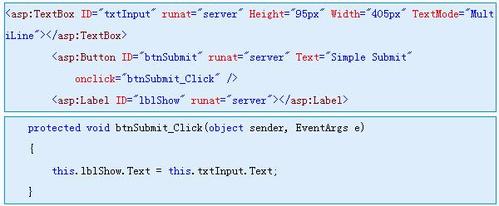ASP.NET优化:Sql注入和Html注入的黑帽SEO
1、注入攻击,包括Sql注入和Html注入。我经常能看到对Sql注入防范的谈论,但对于Html注入,很多人并没有引起足够的重视。为了展示Html注入的效果,我们模仿了一个常见的留言本功能。
首先,在页面声明中添加两个属性设置EnableEventValidation=“false”

2、然后,前台页面和后台代码段分别如下:

3、程序很简单,将用户输入的内容再显示出来而已。运行代码,然后输入我们的恶意代码,提交。

4、我们会发现页面自动跳转到http://too.much.spam/页面!这就是所谓的“Html注入”。当page页面render到客户端后,浏览器会按一个普通的html页面进行解析;当解析到上面的js代码时……
为了避免这种入侵,在asp.net中,我们最简单的处理方式就是对输入的内容进行“Html编码”。将后台代码改为:

5、现在我们再运行代码,发现源代码被原样输出显示在页面,并没有运行。为什么呢?查看输出页面的源代码:
<span id="lblShow"><p>Sanitizing <img src=""INVALID-IMAGE" onerror='location.href="http://too.much.spam/"'>!</p></span>
整理后,我们发现如下的映射转换:
< -- < (less than)
> -- > (greater than)
" -- " (quota)
所以js无法执行,但在页面显示时,我们确能看到“原汁原味”的js内容。
但问题并没有结束,现实世界中,输入的内容除了恶意代码以外,还可能有如下的内容:

6、我们希望显示蓝色的文字,但经过编码后,显然无法达到我们的效果。为此,我们还需要进行更精确的过滤。这也是为什么之前我们要设置EnableEventValidation=“false” ValidateRequest=“false”的现实原因。
其实我最先想到的方案是:首先对整个内容进行编码,然后把我们允许使用的html标签再替换回来。这样是相当保险的,但是在具体的操作中,遇到了很多问题,这个郁闷啊~~~(如果有谁有这种实现的实现代码,千万要拿出来大家分享一下呀)。
我先介绍另一种方案:
首先要取出标签,如,<span style=“ color:blue”>、</span>和<script >,我们的替换范围仅局限于标签 < > 之间的内容。
然后获取所有的标签名称、属性的名称和值,如果有禁止出现的内容,就替换掉。可能的恶意代码形式如下所示:
标签的名称: <script </script
标签里的属性:<span onclick
属性的值:<img onerror=“javascript:'
7、最后,我们对所有的“恶意单词”进行替换:
using System;
using System.Text.RegularExpressions;
/// <summary>
/// Sanitize contains functionality to remove unaccepted tags or attributes
/// </summary>
public static class Sanitize
{
// list of accepted/harmeless tags (in lower case)
private static string[] allowedTags =
{ "p", "h1", "b", "i", "a", "ul", "li", "pre", "hr", "blockquote", "img" };
// list of attributes that need to be sanitized
private static string badAttributes =
"onerror|onmousemove|onmouseout|onmouseover|" +
"onkeypress|onkeydown|onkeyup|javascript:";
// sanitizes the HTML code in $inputHTML
public static string FixTags(string inputHtml)
{
// define the match evaluator
// MatchEvaluator 是一个委托,它调用fixTag方法
MatchEvaluator fixThisLink = new MatchEvaluator(Sanitize.fixTag);
// process each tags in the input string
string fixedHtml = Regex.Replace(inputHtml, //需要替换的字符串
"(<.*?>)", //正则表达式:注意“?”的使用 --贪婪模式
fixThisLink, //委托“实例”做参数
RegexOptions.IgnoreCase);
//整句代码的意思就是:将输入字符串inputHtml中能匹配上"(<.*?>)"的部分(也就是被< >包裹的标签)用fixThisLink方法进行处理
// return the "fixed" input string
return fixedHtml;
}
// remove tag if is not in the list of allowed tags
private static string fixTag(Match tagMatch)
{
string tag = tagMatch.Value;
// extrag the tag name, such as "a" or "h1"
Match m = Regex.Match(tag,
@"</?(?<tagName>[^\s/]*)[>\s/]",
RegexOptions.IgnoreCase);
string tagName = m.Groups["tagName"].Value.ToLower();
// if the tag isn't in the list of allowed tags, it should be removed
if (Array.IndexOf(allowedTags, tagName) < 0)
{
return "";
}
// remove bad attributes from the tag
string fixedTag = Regex.Replace(tag,
"(" + Sanitize.badAttributes + @")(\s*)(?==)", // 注意"?=="的意思 --正向预查
"SANITIZED", RegexOptions.IgnoreCase);
// return the altered tag
return fixedTag;
}
}
注意代码中两处正则表达式的高级用法,贪婪模式和正向预查,详细可参考贪婪模式和正向预查
这里我们就可以看到正则表达式说起到的强大作用——操作字符串的无上利器啊!
8、除了注入攻击,另一种必须使用的技术是nofollow。因为Google的链接价值算法,我们都希望能有高价值的链接能指向我们的网站,以提高我们网站的等级。一种简单的方式就是到其他网站(如新浪)申请一个博客,然后在博客里添加一条链接,指向自己的网站即可。但如果我们自己是新浪,我们当然不愿意有其他人这样做(毕竟我们不知道其他人链接指向的网站究竟是好是坏,如果是一个垃圾网站,会牵连到我们自己的)。但是呢,我们也不愿意完全禁止掉链接的使用(比如简单的对链接进行编码,让链接失去作用),因为毕竟很多链接或许只是内部链接,而且一个能直接点击的链接能带来更好的用户体验。
为了解决这个问题,Google给出了一个方法,在链接中加上关键字nofollow,如下所示:
<a rel=“nofollow” href=“http://too.much.spam”>cool link</a>
这样,链接能直接点击,但不会带来链接价值——即Google不会认为你认可或推荐了该链接指向的网站。看看博客园有没有这样做,……,呵呵,好像没有,很大度哟。不过据说Google也会逐步降低链接价值的作用,谣言了,随他去吧……
9、就直接上代码了:
using System;
using System.Text.RegularExpressions;
/// <summary>
/// NoFollow contains the functionality to add rel=nofollow to unstusted links
/// </summary>
public static class NoFollow
{
// the white list of domains (in lower case)
private static string[] whitelist =
{ "seoasp", "www.seoegghead.com", "www.cristiandarie.ro" };
// finds all the links in the input string and processes them using fixLink
public static string FixLinks(string input)
{
// define the match evaluator
MatchEvaluator fixThisLink = new MatchEvaluator(NoFollow.fixLink);
// fix the links in the input string
string fixedInput = Regex.Replace(input,
"(<a.*?>)",
fixThisLink,
RegexOptions.IgnoreCase);
// return the "fixed" input string
return fixedInput;
}
// receives a Regex match that contains a link such as
// <a href="http://too.much.spam/"> and adds ref=nofollow if needed
private static string fixLink(Match linkMatch)
{
// retrieve the link from the received Match
string singleLink = linkMatch.Value;
// if the link already has rel=nofollow, return it back as it is
if (Regex.IsMatch(singleLink,
@"rel\s*?=\s*?['""]?.*?nofollow.*?['""]?",
RegexOptions.IgnoreCase))
{
return singleLink;
}
// use a named group to extract the URL from the link
Match m = Regex.Match(singleLink,
@"href\s*?=\s*?['""]?(?<url>[^'""]*)['""]?",
RegexOptions.IgnoreCase);
string url = m.Groups["url"].Value;
// if URL doesn't contain http://, assume it's a local link
if (!url.Contains("http://"))
{
return singleLink;
}
// extract the host name (such as www.cristiandarie.ro) from the URL
Uri uri = new Uri(url);
string host = uri.Host.ToLower();
// if the host is in the whitelist, don't alter it
if (Array.IndexOf(whitelist, host) >= 0)
{
return singleLink;
}
// if the URL already has a rel attribute, change its value to nofollow
string newLink = Regex.Replace(singleLink,
@"(?<a>rel\s*=\s*(?<b>['""]?))((?<c>[^'""\s]*|[^'""]*))(?<d>['""]?)?",
"${a}nofollow${d}",
RegexOptions.IgnoreCase);
// if the string had a rel attribute that we changed, return the new link
if (newLink != singleLink)
{
return newLink;
}
// if we reached this point, we need to add rel=nofollow to our link
newLink = Regex.Replace(singleLink, "<a", @"<a rel=""nofollow""",
RegexOptions.IgnoreCase);
return newLink;
}
}